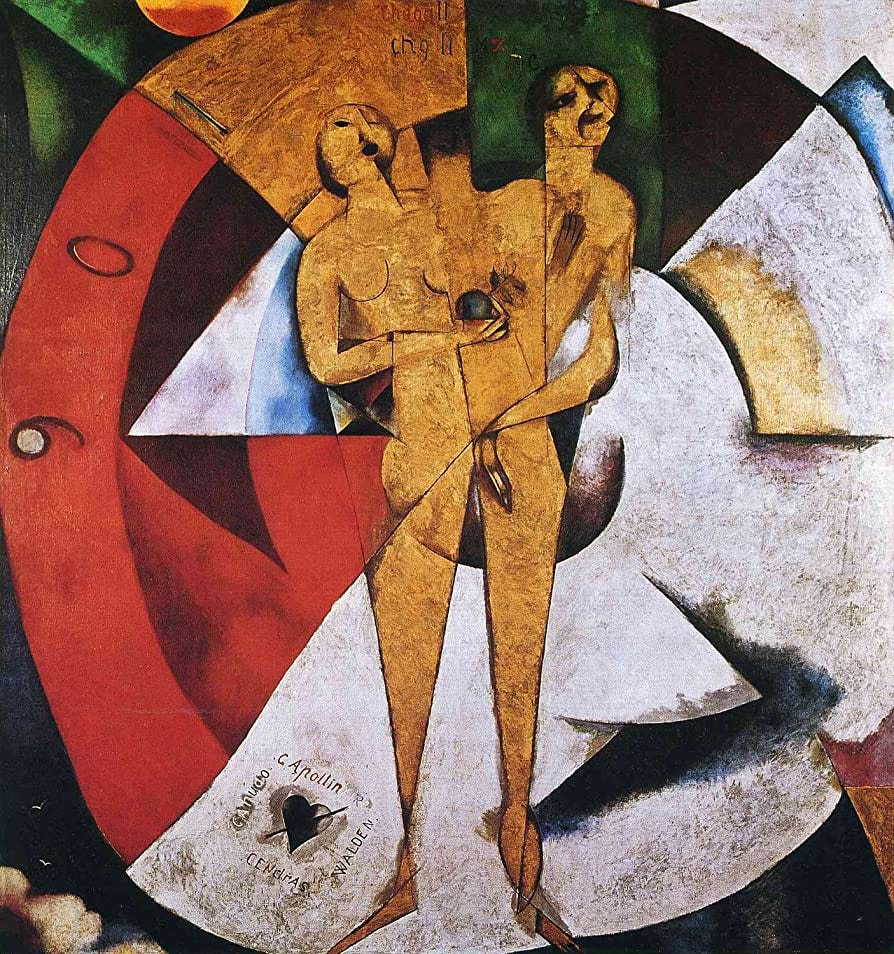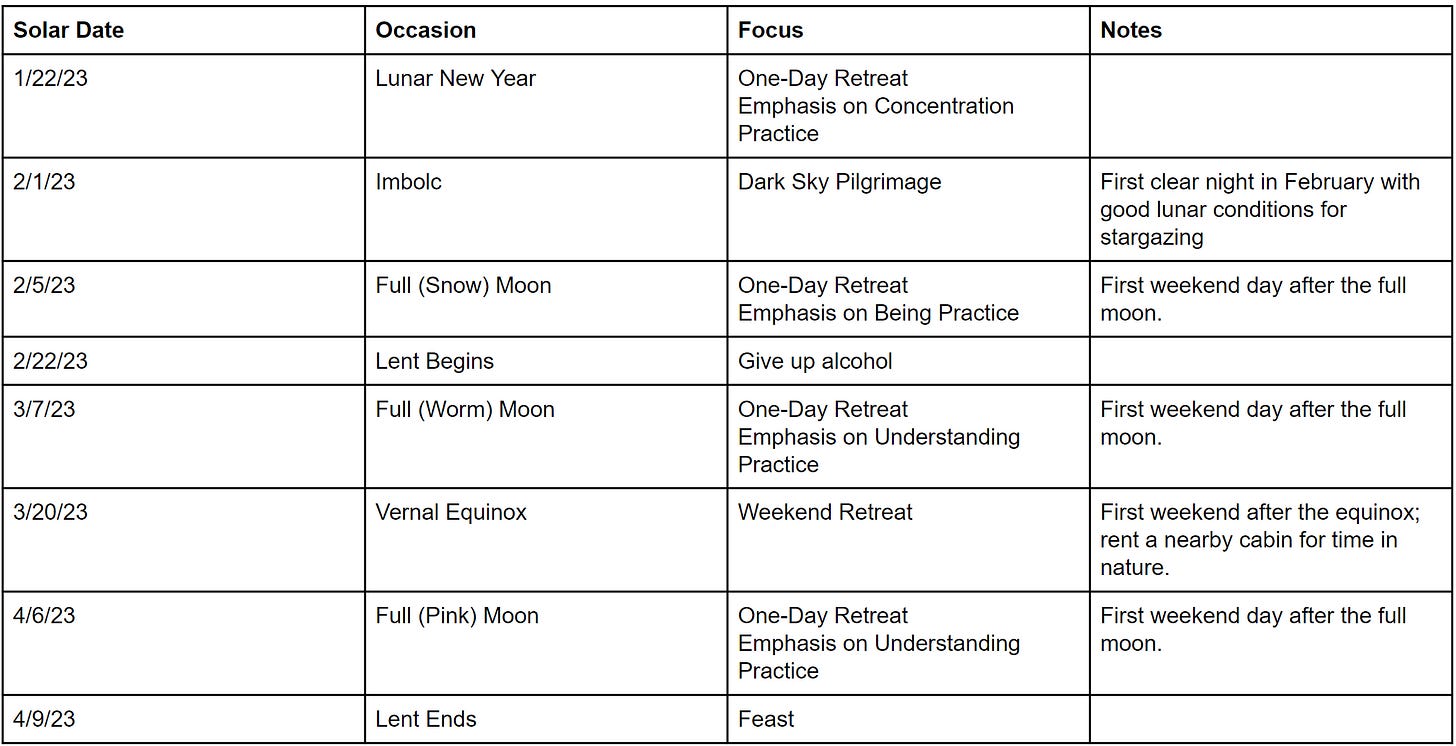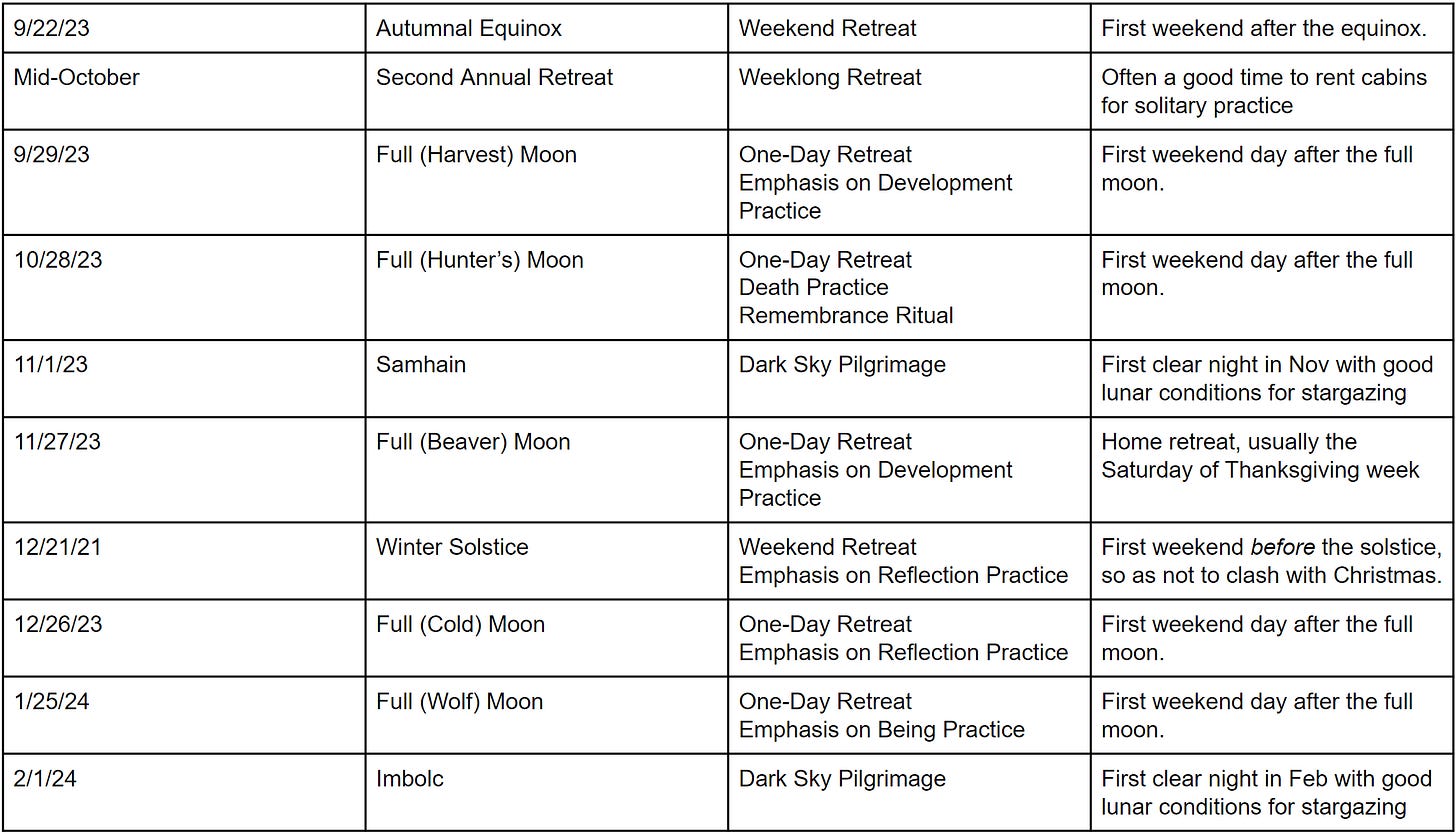On Creating an Annual Practice Calendar
A Year in the Present
Although the main focus of the Mystic’s Almanac is on daily practice, I hope that I will not mislead you about the importance of retreats, holidays and special periods of practice or sacrifice, which are sometimes called “liturgical seasons.” All of these provide important ritual structure to the year and charge your daily practice with meaning.
Below, you will find my ideal annual calendar of practice for the current lunar year. I say ideal because I have never once perfectly executed a planned calendar of practice - life is simply too unpredictable. My real calendar of practice sometimes comes close, but I am not tyrannical about it - I simply do my best, and forgive myself in advance for any failures. I hope you will take the same attitude toward your own.
How I Build My Calendar
As I am the father of a teenager, and a caretaker for my elderly mother, it is important to me to build my practice calendar in such a way that I get ample time to be with my family. As someone who sets his own schedule and works from home, I am able to be more flexible with my retreat periods. Bearing those in mind, here are some of my personal guidelines for setting up my annual practice calendar.
Schedule two week-long retreats per year: one in solitude and one with a teacher or faith community.
Schedule one weekend-long retreat per quarter: at least one in solitude per year.
Schedule one day-long solitary retreat per lunar month.
Schedule one day of extra practice per week.
Sacrifice something for Lent (my mother is Catholic - this is something we do together).
Try to celebrate holidays with friends of different faiths.
Avoid scheduling retreats that cross over major holidays (Christmas, 4th of July, etc.)
Try to schedule retreats that overlap with difficult personal anniversaries (eg, traumatic anniversaries or deaths of people close to you. For instance, I am prone to depressions in early July, due to personal painful experiences.) Anniversaries of this sort are excellent times to give yourself a break from the obligations of work and family, and take time to process and heal your difficult patterns.
Schedule personal or custom holidays at the end of retreats, or during particularly hard times of the year. It’s good to have a feast after a long period of sacrifice, and it’s good to break up notably difficult periods with extra time off for self-compassion. There’s a reason that most cultures schedule a plethora of holidays during the dark, spiritually challenging days of winter.
The Importance of Retreats
Retreats are an essential part of spiritual practice - they serve as a much-needed break for the heart and the spirit, and open up space for deeper, more subtle experiences to emerge and be experienced. The extra practice done on retreat also often leads to deep, powerful subjective events, which are sometimes called “peak experiences.” Sometimes they are physical or subjective experiences of peace, bliss and emotional release. Sometimes they are profound insights (or consolidations of insights) that lead to a breakthrough or a new understanding. Sometimes they are harrowing, painful dark nights of the soul. Sometimes they are an occasion on which a deeply practiced core belief - and ritualized mental boundary - gives way to a direct experience of the true nature of things. These are important milestone events in one’s spiritual journey - so important, in fact, that many teachers say that if you have to choose between daily practice and retreats, it would be better to choose retreats.
One-day retreats are fine to do at home. Generally, I like to pick one category of practice and dive deeply into it from breakfast until dinner. After dinner, I release myself for free time, so long as I maintain silence.
I prefer to take weekend and annual retreats at a nearby cabin or lodge if possible, or at a campsite if the weather allows. It helps to get away from the context of home, especially because I work there. My resources feel freer to deeply focus on practice. I choose themes that are specific to my practice for these longer retreats, and that grow organically out of the training needs I perceive.
The Invincible Summer
Generally speaking, I think it is useful for people to make an effort to build their practice calendar around the turning of seasons, the migrations of animals and the cycles of the moon, rather than solely using the solar calendar and major national holidays. There are many reasons for this, but chief among them is the repair of your connection to your immediate environment, and the regrowth of your ability to be at ease in your own context. As Richard Powers once wrote in his novel The Overstory, speaking to humanity on behalf of nature: “If only your mind were a slightly greener thing, we would drown you in meaning.”
Once you have sufficiently attuned to the movements and rhythms of your natural environment, you will automatically begin to imbue them with individual meaning. This individual meaning does not replace wider cultural or communal meanings; it expands the space of meaning making so that you can contain multiple frames of narrative, salience and satisfaction. I believe this expansion is an unalloyed spiritual good - almost all of us master our communal frame of meaning-making, but by adding a private, individual frame of meaning-making, one gains a separate self-context in which to stand - apart from social pressures, the dominant epistemological paradigms of one’s culture, and the inevitable vicissitudes of life. This gives us the ability to choose what is meaningful. This is Camus’ “invincible summer in the midst of winter” and Emerson’s “man who keeps, with perfect sweetness, the independence of solitude.”
(This powerful, impermeable sense of self seems counterintuitive to mystical practice, which seeks to transcend the self to experience union with the divine, or with all things. But it is not a contradiction - it is in fact precise and masterful skill at delineating the boundaries of the self that enables perception of the sacred context outside those boundaries - that from which each instance of self arises and into which each instance returns.)
However, even if you had no preference for the holidays of your culture and nation, It would be unwise and impractical to completely reject its calendar. There are many practical considerations to take into account: family obligations, work constraints on paid time off, holiday tourist traffic at holy places and wilderness reserves, seasonal fluctuations in price for lodging and other travel costs - the list goes on. A hybrid calendar lets you use both frames of meaning to find the most skillful way forward.
Other Notable Concepts
Liturgical Seasons
A liturgical season is a long period of time - usually more than two weeks - in which special practices are performed, or in which a special intensity of practice is warranted. Examples include Lent and Advent In Western Christianity, Ramadan in Islam, and Ango in Zen Buddhism. I have not included any formal recommendations for liturgical seasons in The Mystic’s Almanac - I encourage you to designate your own as is right for you.
Monkdays
One concept I’ve enjoyed implementing has been “Monkday” - essentially, setting aside Mondays for extra contemplative practice, an all-vegetarian diet, and fasting from more intense sensual pleasures like sex, substance use and even highly flavorful foods.
Dark Sky Pilgrimage
I recommend a quarterly pilgrimage to the nearest suitable Dark Sky location, and practicing there as the sun sets and the stars begin to shine. This can be done more or less often according to your needs and your accessibility to areas free of light pollution. Here in Portland, Oregon, the nearest place where I can see the naked night sky is about a two-hour drive away. You can find the nearest Dark Sky location using this map.
These trips are best undertaken on the new moon, or on nights when the moon has set before the sun. Suitable nights for dark sky pilgrimages are marked on the daily table with a (“ “) logo - these are nights on which the Milky Way is visible, either due to a dim lunar phase or a late moonrise.
Weekly Artist’s Date
This is a concept introduced by Julia Cameron in her program The Artist’s Way that I recommend to any contemplative. Once a week, I like to spend a couple of hours nourishing my spirit with beauty. The best place for me to do this is usually a park or a nature reserve, but occasionally, I’ll opt for a museum, an art gallery or a concert instead. I prefer not to stay at home for this Artist’s Date - movies don’t count, unless I really have no other option.
Retreat Themes and Ideas
In future versions of this document, I will outline some themes and ideas that I think work well as retreat foci.





